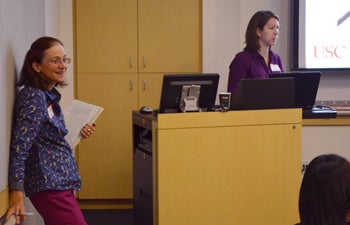Sounds of Science
Working in Sarah Bottjer’s laboratory, USC Dornsife doctoral student Amy Garrison researches the inter-hemispheric connections between vocal-control regions and the amygdala in the brains of songbirds.
As with humans, songbirds are vocal learners and must hear the sounds of adults in order to eventually produce their own mature versions. In the brains of young birds, a feedback pathway exists through which a bird’s current song is compared with the memory of its parent’s song. This pathway also integrates social and motivational factors.
Garrison described her research during a Sept. 28 Southern California conference at USC’s University Park campus. Focusing on the study of hearing and vocal communication, the conference was co-organized by Bottjer, professor of neurobiology at USC Dornsife.

Amy Garrison (right) works in the laboratory of conference co-organizer Sarah Bottjer (left), professor of neurobiology at USC Dornsife. Garrison researches the inter-hemispheric connections between vocal-control regions and the amygdala in the brains of songbirds.
Held in the Hedco Neuroscience Building, the conference drew 50 attendees from institutions including UCLA; University of California at San Diego; University of California at Irvine; University of Arizona; and USC. Organized by USC Dornsife and UCI, the event brought together those who research hearing and vocal communication and their applications in treating hearing disorders and diseases.
“This conference represented a tremendous opportunity to bring together researchers of diverse backgrounds who all investigate hearing and vocal communication,” Bottjer said. “Participants learned from one other in a very interdisciplinary way.”
At the conference, Garrison elaborated on her songbird research, describing a cortical region of the avian brain that receives vocal input and feeds back into the pathway. She said her results indicate that this region not only creates feedback circuits between both sides of the brain, but it does so through the amygdala, the processor of memory, emotions and social interactions in humans.
Thus, she said, the amygdala may contribute to vocal learning in songbirds by providing information about social settings and emotional state. For example, the social interaction between a parent and its young might enhance the offspring’s ability to learn its parent’s specific vocal pattern.
Other presentation topics ranged from studying the impact of music practice on neurodevelopment in children to the function of bipolar neurons in the inner ear, technological advances related to cochlear implants, and the role of genetics during inner ear development.

The conference drew 50 scientists from UCLA; University of California at San Diego; University of California at Irvine; University of Arizona; and USC. Here attendees examine research posters on display.
“This type of semi-formal conference is a great way to cross-fertilize between different areas of research ranging from molecular genetics of hearing loss to cognitive aspects of auditory experience during development,” Bottjer said. “The ability to participate in a small conference also enriches the experience of graduate students and postdoctoral scholars in USC’s NIH-funded training program in hearing and communication neuroscience, since they present results from their own research and hear about the work of other scientists.”
Another USC presenter was Robert Shannon, professor of research and otolaryngology at the Keck School of Medicine of USC. He presented data on auditory brainstem implants in children. His research outlines how cochlear implants are not always best suited for restoring functional hearing, since they have no impact on patients who have lost their auditory nerve due to genetic or congenital defects, tumor growth and subsequent surgical removal or temporal bone fracture.
Li Tao, a postdoctoral scientist at the Keck School of Medicine of USC, also presented his work on epigenetic regulation of genes during the development of the inner ear in mammals. Tao works in the laboratory of Neil Segil, research associate professor at the Division of Cell Biology and Genetics.
Garrison said the conference helped her to advance her research.
“The best insights and questions often come from someone who’s slightly outside of the field,” Garrison said. “I got a couple of great ideas for my birdsong project from people who study children with cochlear implants. An interdisciplinary conference like this helps us find fresh perspectives on our data.”